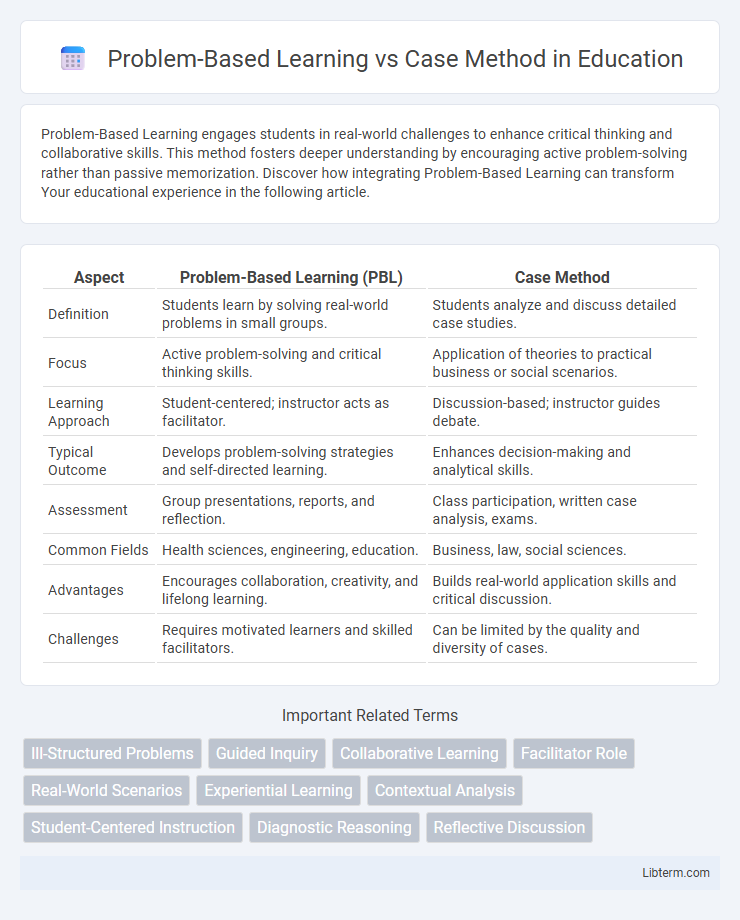Problem-Based Learning engages students in real-world challenges to enhance critical thinking and collaborative skills. This method fosters deeper understanding by encouraging active problem-solving rather than passive memorization. Discover how integrating Problem-Based Learning can transform Your educational experience in the following article.
Table of Comparison
| Aspect | Problem-Based Learning (PBL) | Case Method |
|---|---|---|
| Definition | Students learn by solving real-world problems in small groups. | Students analyze and discuss detailed case studies. |
| Focus | Active problem-solving and critical thinking skills. | Application of theories to practical business or social scenarios. |
| Learning Approach | Student-centered; instructor acts as facilitator. | Discussion-based; instructor guides debate. |
| Typical Outcome | Develops problem-solving strategies and self-directed learning. | Enhances decision-making and analytical skills. |
| Assessment | Group presentations, reports, and reflection. | Class participation, written case analysis, exams. |
| Common Fields | Health sciences, engineering, education. | Business, law, social sciences. |
| Advantages | Encourages collaboration, creativity, and lifelong learning. | Builds real-world application skills and critical discussion. |
| Challenges | Requires motivated learners and skilled facilitators. | Can be limited by the quality and diversity of cases. |
Introduction to Problem-Based Learning and Case Method
Problem-Based Learning (PBL) engages students in collaborative problem-solving by presenting real-world challenges without predefined solutions, fostering critical thinking and self-directed learning. The Case Method uses detailed narratives of complex scenarios to analyze decisions and outcomes, emphasizing practical application of theoretical knowledge. Both methods immerse learners in active exploration, though PBL centers on open-ended problem resolution while the Case Method concentrates on reviewing and discussing specific instances.
Historical Origins and Development
Problem-Based Learning (PBL) originated in the late 1960s at McMaster University in Canada, designed to foster self-directed learning through real-world problems. The Case Method traces back to Harvard Business School in the early 20th century, emphasizing decision-making and discussion based on detailed case studies. Both approaches evolved to enhance critical thinking, but PBL emphasizes learner-driven inquiry, while the Case Method centers on instructor-led analysis of specific scenarios.
Core Principles and Approaches
Problem-Based Learning (PBL) emphasizes student-centered inquiry where learners collaboratively identify problems, research solutions, and apply knowledge to real-world scenarios, fostering critical thinking and self-directed learning. The Case Method involves analyzing specific, detailed case studies to develop decision-making and analytical skills, with a focus on discussion and reflection guided by instructors. Both approaches prioritize active learning but differ in structure; PBL promotes continuous problem exploration, whereas the Case Method centers on dissecting singular, concrete examples.
Structure and Implementation in the Classroom
Problem-Based Learning (PBL) centers on student-driven inquiry where learners collaboratively identify and solve real-world problems, fostering critical thinking and self-directed research. The Case Method uses instructor-provided scenarios to prompt analysis, discussion, and application of theoretical concepts, often guided by strategic questioning from the teacher. Implementation of PBL requires flexible classroom arrangements and access to diverse resources, whereas the Case Method relies on well-prepared cases and structured debriefing to ensure comprehensive understanding.
Roles of Students and Instructors
In Problem-Based Learning (PBL), students actively engage in identifying problems, conducting research, and collaboratively constructing knowledge, serving as self-directed learners and critical thinkers. Instructors act as facilitators who guide inquiry, provide resources, and encourage reflection without directly delivering content. Contrarily, the Case Method positions students as analysts who apply theoretical frameworks to real-world scenarios, with instructors leading discussions, challenging assumptions, and steering the learning process to deepen understanding.
Types of Problems and Cases Used
Problem-Based Learning uses ill-structured, real-world problems that require students to identify what they need to learn to solve complex issues, often without a predefined solution. The Case Method typically employs detailed narrative cases that present specific scenarios or situations, encouraging analysis and discussion based on established facts and outcomes. Both approaches emphasize critical thinking, but Problem-Based Learning centers around open-ended problems, while the Case Method focuses on structured case analysis.
Learning Outcomes and Skills Developed
Problem-Based Learning (PBL) emphasizes critical thinking, self-directed research, and collaborative problem-solving skills, leading to improved analytical abilities and real-world application of knowledge. The Case Method develops decision-making, communication, and strategic thinking skills by engaging students with real-life scenarios that require evaluation of complex information and justification of choices. Both approaches enhance problem-solving capabilities but PBL fosters independent learning while the Case Method strengthens practical reasoning in professional contexts.
Advantages and Limitations of Each Method
Problem-Based Learning (PBL) enhances critical thinking and self-directed learning by presenting students with real-world problems, fostering collaboration and practical problem-solving skills; however, it can be time-consuming and may lack structured content coverage. The Case Method emphasizes analytical reasoning through detailed examination of real-life scenarios, promoting decision-making skills and contextual understanding, though it may limit creativity and depend heavily on the quality of case materials. Both methods require skilled facilitation and may pose challenges in assessment consistency and scalability across diverse educational settings.
Suitability for Different Disciplines
Problem-Based Learning (PBL) is highly suitable for disciplines requiring critical thinking and real-world problem-solving such as medicine, engineering, and social sciences, where students engage actively with complex scenarios. The Case Method excels in business, law, and public policy education by fostering analytical skills through detailed examination of specific business or legal cases, encouraging debate and decision-making. Both methods enhance active learning but align differently with discipline-specific goals, with PBL emphasizing iterative problem-solving and the Case Method focusing on contextual analysis and strategic reasoning.
Choosing the Right Method for Your Educational Goals
Selecting the right educational method depends on your specific learning objectives and subject matter complexity. Problem-Based Learning (PBL) excels in developing critical thinking and problem-solving by engaging students in real-world scenarios requiring active inquiry, while the Case Method emphasizes analysis and discussion of predefined narratives to enhance decision-making skills and theoretical application. Align PBL with goals aiming for independent exploration and adaptability; opt for the Case Method when fostering structured analysis and collaborative debate is paramount.
Problem-Based Learning Infographic

 libterm.com
libterm.com